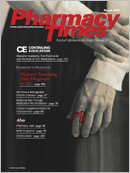Publication
Article
Pharmacy Times
Be Proactive with Pharmacy-based Health Clinics
Author(s):
Pharmacy-based health clinics,run by nurse practitioners andphysician assistants, seem tobe popping up everywhere across thecountry. According to USA Today, approximately150 retail pharmacy-basedhealth clinics are now in place nationwide.1 Peter Miller, chief executive officerof Take Care Health Systems, estimatesthat thousands of new clinicscould be opened over the next 5 years.2
Indeed, retail pharmacy chains andmass merchandisers are continuing toannounce new or expanding walk-inclinic services. In the past year, CVS hasacquired MinuteClinic, the largest providerof retail-based health clinics inthe United States. Walgreens has partneredwith Take Care Health Systems,RediClinic, and Pinnacle EasyCare toopen Health Corner Clinics. Target andMedcor are operating Target Clinics inselect locations, and WalMart is workingwith RediClinic. These clinics notonly give patients easy access to healthcare services, but present a great opportunityfor pharmacists to workclosely with clinic staff to prevent medicationerrors.
Do you have a clinic opening or underconsideration for your store? If so, makesure that you meet with all the clinicpractitioners as well as their office staff.During the meeting, consider discussingand carrying out the following safe practicerecommendations. (Note that thesame steps should be considered foroffice practices from which you frequentlyreceive prescriptions.)
?Introduce the clinic personnel to allthe staff in the pharmacy. Takethem for a tour, and show themhow prescription intake, preparation,and dispensing are performed.
?If you have prescription-scanningcapabilities, show them what ascanned prescription looks like inyour system. Demonstrate how differentprescription blanks scan,and point out which ones to avoidusing so as not to distort the actualorder (eg, blanks with watermarksdesigned to discouragediversion). Help them design prescriptionblanks that include indicationicons.
?Encourage them to use an electronicprescribing system. Workwith them and their vendor to ensurethat information is printed,faxed, or sent electronically in aclear format.
?Ask them to include the indicationfor use whenever they write, sendelectronically, or call in a prescription
?Ask the prescriber to print his orher name on the prescription orcircle it if it is preprinted on theprescription blank. Patients maynot remember hearing the provider'sname?which makes it difficultfor a pharmacist to communicatedirectly with the prescriberwhen there is an issue with theprescribed therapy.
?Review with prescribers the variousinformational tools, patientprofiles, and data sets availablethrough your pharmacy systemand pharmacy benefit managerconnectivity
?Describe how drug-utilization reviewand prior-authorization processestake place
?Recommend drug information referencematerials that they shouldhave available in their clinic or office
?Encourage them to contact one ofyour pharmacists for any druginformationquestions
?Let them know that you will dispenseappropriate measuring devicesevery time they order a liquidmedication. Make sure that theyknow the risks of using or recommendingparenteral syringes fororal liquid use.
?Share with them safety tools (eg,FDA-Institute for Safe MedicationPractices Abbreviations CampaignToolkit) and error-prevention strategies
?Let them know that safety is yourpriority when filling prescriptions,and invite them to be part of yoursafety team
Dr. Gaunt is a medication safetyanalyst and the editor of ISMPMedication Safety Alert!Community/Ambulatory CareEdition.
Subscribe to Newsletter
Pharmacy Times and the Institute for SafeMedication Practices (ISMP) would like to makecommunity pharmacy practitioners aware of a publicationthat is available.
The ISMP Medication Safety Alert! Community/Ambulatory Care Edition is a monthly compilation ofmedication-related incidents, error-prevention recommendations,news, and editorial content designedto inform and alert community pharmacypractitioners to potentially hazardous situationsthat may affect patient safety. Individual subscriptionprices are $45 per year for 12 monthlyissues. Discounts are available for organizationswith multiple pharmacy sites. This newsletter isdelivered electronically. For more information, contactISMP at 215-947-7797, or send an e-mailmessage to community@ismp.org.
References
1. Schmit J. Could walk-in retail clinics help slow rising health costs? USA Today.August 14, 2006. Available at: http://www.usatoday.com/money/industries/health/2006-08-24-walk-in-clinic-usat_x.htm. Accessed January 12, 2007.
2. ABC News. Walk-in Medical Clinics Take Retailers by Storm: Patients LikeAlternative's Convenience, Short Wait. October 19, 2006. Available at:http://abcnews.go.com/WNT/PrescriptionForChange/story?id=2586216&page=1.Accessed January 12, 2007.







